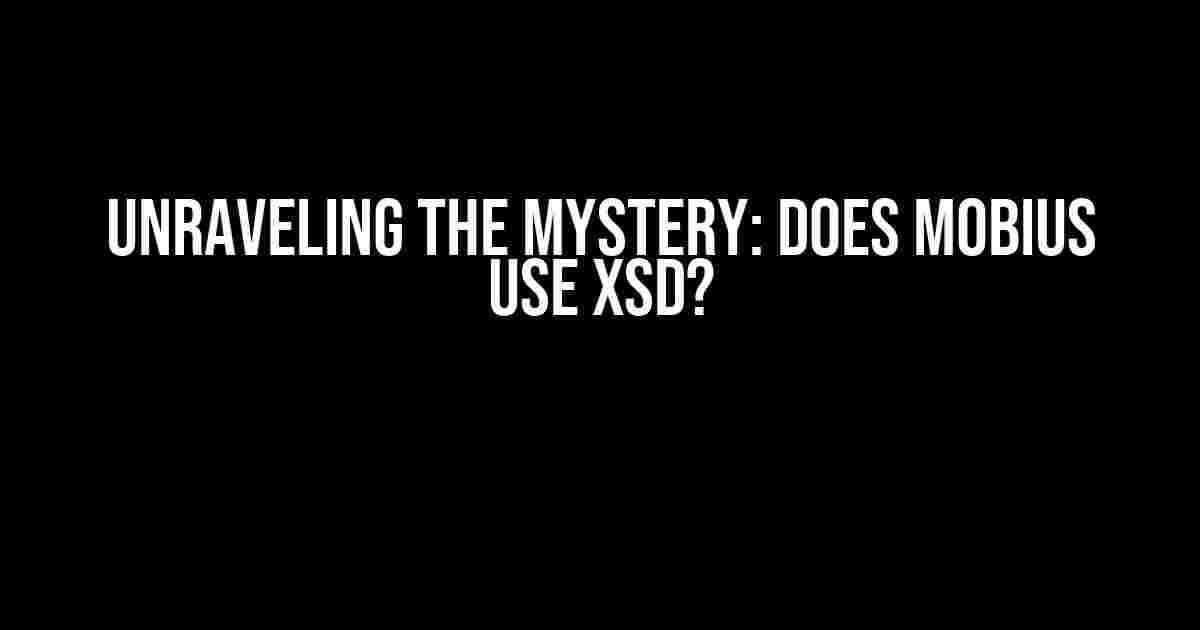When it comes to XML schema definitions, the debate rages on: does Mobius, the popular data integration platform, utilize XSD (XML Schema Definition) to validate and structure its data? In this article, we’ll embark on a quest to uncover the truth behind this burning question.
The Importance of XSD in Data Integration
In the realm of data integration, XML schema definitions play a vital role in ensuring data consistency, validity, and integrity. XSD provides a standardized way to define the structure and constraints of an XML document, making it an essential tool for data exchange and processing.
A Brief Overview of Mobius
Mobius, developed by Amdocs, is a robust data integration platform designed to streamline data exchange between disparate systems, applications, and services. With its ability to handle complex data transformations, mappings, and routing, Mobius has become a popular choice for organizations seeking to overcome data integration challenges.
The XSD Conundrum: Does Mobius Use XSD?
So, does Mobius utilize XSD to validate and structure its data? The answer, much like the Mobius strip, is not a straightforward yes or no.
Mobius’ Approach to Data Validation
Mobius employs its own proprietary data validation mechanism, which is distinct from traditional XSD-based validation. This approach focuses on runtime validation, where data is validated against a set of predefined rules and constraints during processing.
// Mobius data validation example
if (record.field1 > 10) {
// perform validation logic
} else {
// handle validation error
}
This approach provides a more flexible and dynamic way to validate data, allowing for greater control over the validation process. However, it deviates from the traditional XSD-based validation method, where data is validated against a pre-defined schema.
XSD Support in Mobius: A Hidden Gem?
Although Mobius doesn’t directly utilize XSD for data validation, it does provide support for XSD in certain aspects of its functionality.
| XSD Support in Mobius | Description |
|---|---|
| XML Schema Import | Mobius allows users to import XSD files, which can be used to generate XML documents or validate data against the imported schema. |
| XSD-Based Data Mapping | Mobius provides XSD-based data mapping capabilities, enabling users to map data from an XSD-defined source to a target system. |
| XSD Validation in Custom Scripts | In certain scenarios, Mobius allows users to write custom scripts that utilize XSD validation, providing an additional layer of data validation and control. |
While Mobius doesn’t rely on XSD for data validation, its support for XSD in various aspects of its functionality is undeniable.
Best Practices for XSD Integration in Mobius
When working with Mobius, incorporating XSD into your data integration strategy can greatly enhance data quality and consistency. Here are some best practices to keep in mind:
- Use XSD to Define Data Structures: Leverage XSD to define the structure and constraints of your data, ensuring consistency across different systems and applications.
- Import XSD Files into Mobius: Take advantage of Mobius’ XML schema import feature to utilize XSD-defined data structures in your data integration flows.
- Utilize XSD-Based Data Mapping: Use Mobius’ XSD-based data mapping capabilities to ensure accurate and consistent data transformations between systems.
- Implement Custom XSD Validation Scripts: Write custom scripts that utilize XSD validation to provide an additional layer of data validation and control in your Mobius flows.
Conclusion
In conclusion, while Mobius doesn’t directly use XSD for data validation, it does provide support for XSD in various aspects of its functionality. By understanding Mobius’ approach to data validation and leveraging XSD in your data integration strategy, you can ensure data consistency, validity, and integrity across your organization.
So, the next time someone asks, “Does Mobius use XSD?”, you can confidently say, “It’s not a simple yes or no, but rather a nuanced understanding of Mobius’ data validation and XSD support.”
Further Reading
Stay tuned for more in-depth articles and tutorials on Mobius, XSD, and data integration best practices!
Frequently Asked Question
Get answers to your burning questions about Mobius and XSD
Does Mobius use XSD for data validation?
Yes, Mobius uses XSD (XML Schema Definition) for data validation. This ensures that the data exchanged between systems is correct and adheres to a standardized format, reducing errors and inconsistencies.
What is the role of XSD in Mobius?
XSD plays a crucial role in Mobius as it defines the structure and constraints of the data, allowing for efficient data exchange and processing. It ensures that the data is correct, complete, and consistent, which is essential for making informed business decisions.
How does Mobius leverage XSD for data integration?
Mobius leverages XSD to create a common language for data integration, enabling seamless communication between different systems and applications. This ensures that data is accurately transformed, validated, and transmitted, facilitating efficient data exchange and integration.
Can I customize XSD in Mobius for specific business needs?
Yes, Mobius allows you to customize XSD to meet specific business requirements. This flexibility enables you to adapt to changing business needs, ensure compliance with industry standards, and improve data quality and integrity.
What are the benefits of using XSD in Mobius?
Using XSD in Mobius offers several benefits, including improved data quality, reduced errors, increased efficiency, and enhanced scalability. It also enables better data governance, ensures compliance with industry standards, and facilitates smoother data integration and exchange.
